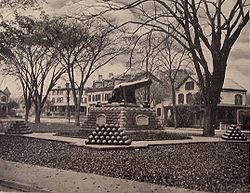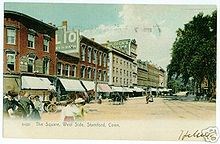
Welcome to Stamford, CT
County: Fairfield
Population: 118,068
Square Miles: 52
Distance to Major Cities:
Boston: 159 miles
Hartford: 68 miles
New York City: 32 miles
Welcome to Stamford, CT, eighth largest city in New England and a burgeoning world financial center. Dubbed by some as a mini-New York, Stamford calls itself “the city that works” and it does, for nearly 120,000 people. Stamford encompasses 52 square miles, of which nearly 25% is water. Its 45 different neighbor-hoods are often shaped by geography: sound-focused, river-based, or nestled along the glacier-carved rock ridges. In each of these neighborhoods you find very different real estate… historic single family homes, gracious colonials, town homes, luxury condos and rental properties. Its people represent hundreds of nations and languages from all around the world. Indeed, about 37% of Stamford residents were born in another country and have come here to make their home. Not surprisingly, their restaurants offer a broad sampling of international cuisine, from fresh Mexican fare to spicy Thai or Indian food, French haute cuisine, European style cafés, dozens of authentic Italian pizzerias, Irish pubs, and just-caught New England seafood shops. Bargain hunters from all over the tri-state area come to Stamford to shop the hundreds of stores at the Stamford Town Center. Its soaring 8-level open architecture was featured in Woody Allen’s “Scenes From a Mall”. Stamford Town Center features Macy’s, Apple, H & M and many other top notch stores and is conveniently located downtown off Interstate 95. Stamford also boasts a thriving antiques district along Canal, Jefferson and John Streets.
The Stamford public school system has a very informative website which offers translations to over 20 languages besides English. This reflects Stamford’s pride in its international community and the respect offered all children in the Stamford schools.
The Stamford Museum and Nature Center is on a 118-acre site in the northern end of town, and has a collection of works by Gutzon Borglum, the sculptor of Mount Rushmore, who was a Stamford resident for a decade. Stamford Center for the Arts: The Palace Theatre, originally opened as a vaudeville house in 1927, reopened as a nonprofit theater in 1983. It was joined in 1992 by the Rich Forum, another downtown venue. The Rich Forum is now being rented by NBC Universal as a television studio.
Stamford is located on the main branch of the New Haven Line on the Metro-North Railroad, the commuter rail system for northern metropolitan New York City. Stamford is the third busiest station on the Metro North system and serves as a major transfer point for local trains. Stamford Station is also the terminus of a Metro-North branch that ends in New Canaan. Two smaller train stations in Stamford are Glenbrook and Springdale, both part of the New Canaan branch. Two limited-access highways run through the city – Interstate 95 serves as the main route through downtown Stamford and the Merritt Parkway runs through the northern part of the city. Stamford is home to many corporate headquarters such as World Wrestling Entertainment, Tasty Bite and Pitney Bowes. UBS has its North American headquarters here as well as the Royal Bank of Scotland. Stamford has been home to many famous people, among them band leader Benny Goodman, and actors Christopher Lloyd and Bob Crane. Stamford real estate opportunities are plentiful for both seasoned investors and first-time homebuyers.

1911 Post Card Bank and Main Streets

USS Kearsarge Gun Memorial—Columbus Park
Stamford, CT History
The original Native Americans called this area Rippowam, a name carried by the meandering river that winds it way to Long Island Sound. Early Europeans bought the land in 1640, and quickly developed a thriving agricultural community. Soon, they discovered that the harbor and proximity to New York made this a perfect base for water commerce. At the same time, the lower Rippowam River (also called Mill River) was used for grist, wire, saw and woolen mills that formed the nucleus for the growing industrial character of the city. Water commerce was so important that the city dug a canal to extend the harbor inland, to the current Jefferson and Dock Streets, to serve the shipping needs of its growing industrial base.
Starting in the late 19th century, New York residents built summer homes on the shoreline, and even back then there were some who moved to Stamford permanently and started commuting to Manhattan by train, although the practice became more popular later. Stamford incorporated as a city in 1893.

1906 Postcard—West Side of The Square

